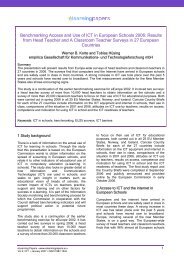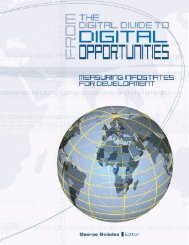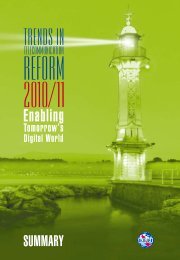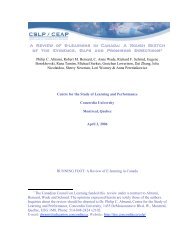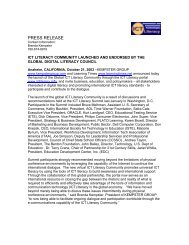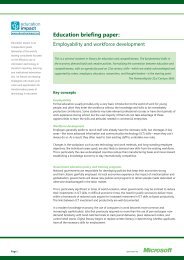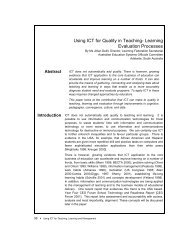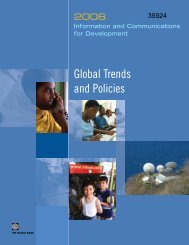The Digital Opportunity Index (DOI) - ITU
The Digital Opportunity Index (DOI) - ITU
The Digital Opportunity Index (DOI) - ITU
You also want an ePaper? Increase the reach of your titles
YUMPU automatically turns print PDFs into web optimized ePapers that Google loves.
Statistical Chapter Three Annex<br />
ers: the UAE incumbent Etisalat reports that after<br />
rates of its high-speed Internet service Al Shamil<br />
were reduced by 46 per cent in 2005, the number<br />
of subscribers grew by 140 per cent. 16 Greater<br />
choice of products, pricing and access platforms<br />
has fuelled growth in broadband in the UK. 17<br />
3.5 Key Trends in the Information<br />
Society<br />
3.5.1 Cutting the cord<br />
<strong>The</strong> <strong>DOI</strong> measures the proportion of households<br />
with access to fixed lines (widely available from<br />
surveys or by derivation, i.e., residential telephone<br />
lines per 100 households). Fixed lines have historically<br />
been important for voice, faxes, text and data<br />
communications. <strong>The</strong> <strong>DOI</strong> shows that fixed lines<br />
in homes are declining, mainly in response to the<br />
rise of mobile communications. This trend makes<br />
it likely that countries will never achieve 100 per<br />
cent fixed household penetration.<br />
A good example is Finland, which has seen a dramatic<br />
drop in the proportion of homes with fixed<br />
telephones from 94 per cent in 1990 to 64 per cent<br />
in 2003 (Figure 3.6) and an estimated 57 per cent<br />
by 2005. 18 Nearly all Finnish from homes that do<br />
not have a fixed line nevertheless own a mobile<br />
phone or have access to one. Remarkably, over 80<br />
per cent of Finnish homes with a fixed telephone<br />
line are connected to DSL broadband service -<br />
many Finns are keeping their fixed telephone line<br />
mainly for broadband access.<br />
Given the preference of many users for mobile<br />
rather than fixed telephony, this indicator could<br />
be adapted to measure the existence of a telephone<br />
in the household, regardless of whether it<br />
is fixed or mobile. However, the <strong>DOI</strong> already measures<br />
mobile penetration through a per capita subscription<br />
indicator, since mobile telephones are<br />
personal and are less likely to be shared. While<br />
mobile telephone networks are evolving in their<br />
ability to offer higher-speed Internet access, highspeed<br />
wireless networks have yet to be widely<br />
launched around the world. <strong>The</strong>re are, in general,<br />
only a small proportion of households that currently<br />
use high-speed mobile networks to access<br />
the Internet, although fixed usage of 3G wireless<br />
for broadband Internet service is increasing. One<br />
example is the Czech Republic, where more than<br />
a third of the one million broadband subscribers<br />
at the end of December 2006 were using fixed<br />
wireless broadband. 19 Despite this reduction in<br />
fixed lines in developed nations and lower rates<br />
of growth in developing ones, an indicator measuring<br />
the availability of telephony and potential<br />
home access to the Internet is vital for policy<br />
analysis.<br />
<strong>The</strong> growing use of Voice over Internet Protocol<br />
(VoIP) worldwide suggests that over time, fixed<br />
voice services will be provided over broadband<br />
Figure 3.6: Abandoning fixed lines<br />
Proportion of Finnish households with telephones<br />
Proportion of Finnish households with fixed lines,<br />
mobile phones and both, 2005<br />
100<br />
80<br />
60<br />
40<br />
20<br />
0<br />
1990 1995 1998 2001 2003<br />
Mobile<br />
only<br />
47%<br />
Fixed<br />
only 7% Both<br />
46%<br />
Fixed<br />
Mobile<br />
Source: Adapted from Statistics Finland (left) and Eurobarometer (right).<br />
48



